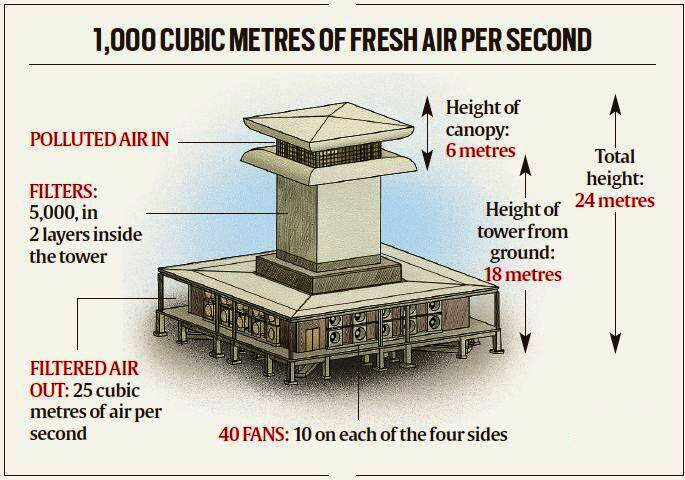Biodiversity & Environment
Delhi’s New Smog Tower
- 24 Aug 2021
- 6 min read
Why in News
Recently, the Chief Minister of Delhi inaugurated the country's first 'smog tower’ in Connaught Place.
- It was inaugurated months before the pollution level spikes in the national capital due to burning of crop waste (stubble burning) by farmers.
Key Points
- Background:
- In 2019, the Supreme Court directed the Central Pollution Control Board (CPCB) and the Delhi government to come up with a plan to install smog towers to combat air pollution.
- IIT-Bombay then submitted a proposal for the towers to the CPCB.
- In January 2020, the Supreme Court directed that two towers should be installed by April as a pilot project.
- The smog tower at Connaught Place (CP) is the first of these towers. The second tower, being constructed at Anand Vihar in east Delhi with CPCB as the nodal agency, is nearing completion.
- About:
- Smog towers are structures designed to work as large-scale air purifiers.
- They are usually fitted with multiple layers of air filters, which clean the air of pollutants as it passes through them.
- China has the world’s largest smog tower.
- Working of the Tower:
- It uses a ‘downdraft air cleaning system’ where polluted air is sucked in at a height of 24 m, and filtered air is released at the bottom of the tower, at a height of about 10 m from the ground.
- It is different from the system used in China, where a 60-metre smog tower uses an ‘updraft’ system — air is sucked in from near the ground, and is propelled upwards by heating and convection. Filtered air is released at the top of the tower.
- It uses a ‘downdraft air cleaning system’ where polluted air is sucked in at a height of 24 m, and filtered air is released at the bottom of the tower, at a height of about 10 m from the ground.
- Developed by:
- Tata Projects Limited (TPL) built it with technical support from IIT-Bombay and IIT-Delhi, which will analyse its data.
- National Biofuel Coordination Committee (NBCC) India Ltd is the project management consultant.
- Delhi Pollution Control Committee was in charge of the Project.
- Need:
- According to a report by CPCB, an increase of 258% to 335% has been observed in the concentration of PM10 in Delhi since 2009.
- But the most prominent pollutant in Delhi and neighbouring areas is PM2.5
- PM2.5 refers to fine particles which penetrate deep into the body and fuel inflammation in the lungs and respiratory tract, leading to risks of cardiovascular and respiratory problems, including a weak immune system.
- Delhi was the most polluted capital city in the world in 2020 for the third consecutive year, according to a report by a Swiss group (released in March 2021) that ranked cities based on their air quality measured in terms of the levels of ultrafine particulate matter (PM 2.5).
- Challenges:
- It may provide immediate relief from air pollution in a small area but they are a costly quick-fix measure with no scientific evidence to back their efficacy in the long term.
- The tower could have an impact on the air quality up to 1 km from the tower.
- However, the actual impact will be assessed by IIT-Bombay and IIT-Delhi in a two-year pilot study that will also determine how the tower functions under different weather conditions, and how levels of PM2.5 vary with the flow of air.
- Other Steps Taken to Tackle the Problem of Pollution in Delhi:
- Subsidy to farmers for buying Turbo Happy Seeder (THS) which is a machine mounted on a tractor that cuts and uproots the stubble, in order to reduce stubble burning.
- The introduction of BS-VI vehicles, push for electric vehicles (EVs), Odd-Even as an emergency measure and construction of the Eastern and Western Peripheral Expressways to reduce vehicular pollution.
- Implementation of the Graded Response Action Plan (GRAP). It is a set of curbs triggered in phases as the air quality deteriorates, which is typical of the October-November period.
- Use of Green Crackers.
- Development of the National Air Quality Index (AQI) for public information under the aegis of the CPCB.
Way Forward
- Since there is no scientific evidence that proves its efficiency, governments should instead address root causes and promote renewable energy to tackle air pollution and reduce emissions.
- It will be really unfortunate if other cities decide to follow suit and set up these expensive, ineffective towers.







